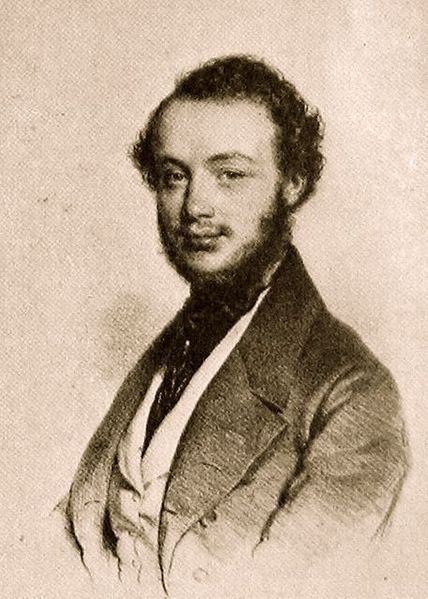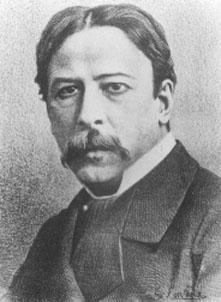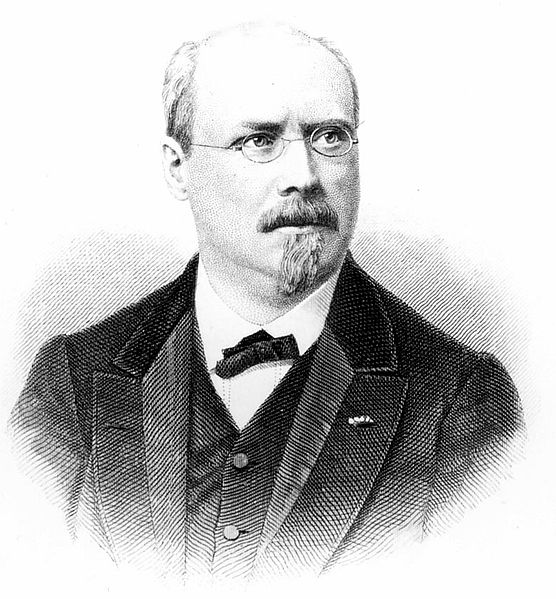<Back to Index>
- Composer and Violinist Henri François Joseph Vieuxtemps, 1820
- Composer and Double Bass Virtuoso Giovanni Bottesini, 1821
- Composer and Pianist Joseph Joachim Raff, 1822
PAGE SPONSOR

Henri François Joseph Vieuxtemps (17 February 1820 – 6 June 1881) was a Belgian composer and violinist. He occupies an important place in the history of the violin as a prominent exponent of the Franco - Belgian violin school during the mid 19th century.
Vieuxtemps was born in Verviers, Belgium, son of a weaver and amateur violinist and violin maker. He received his first violin instruction from his father and a local teacher and gave his first public performance at the age of six, playing a concerto by Pierre Rode. Soon he was giving concerts in various surrounding cities, including Liège and Brussels where he met the violinist Charles Auguste de Bériot, with whom he began studies. In 1829, Bériot took him to Paris where he made a successful concert debut, again with a concerto by Rode, but he had to return the next year because of the July Revolution and Bériot's marriage to his mistress Maria Malibran and departure on concert tour. Back in Brussels, Vieuxtemps continued developing his violin technique on his own, his musicianship deepened by playing with the deeply musical mezzo - soprano Pauline Viardot, Malibran's sister. A tour of Germany in 1833 brought friendship with Louis Spohr and with Robert Schumann, who compared the boy to Niccolò Paganini. During the following decade he visited various European cities, impressing with his virtuosity not only audiences but also famous musicians such as Hector Berlioz and Paganini himself, whom he encountered at his London debut in 1834.
But he had aspirations of becoming a composer as well and, having already taken lessons with the respected Simon Sechter in Vienna, spent the winter of 1835 – 1836 studying composition with Anton Reicha in Paris. His first violin concerto, later published as Concerto No. 2, dates from this time.
Vieuxtemps's Violin Concerto No. 1 was acclaimed when he played it in Saint Petersburg on his second visit in 1840 and in Paris the next year; Berlioz found it "a magnificent symphony for violin and orchestra". Based in Paris, Vieuxtemps continued to compose with great success and perform throughout Europe. With the pianist Sigismond Thalberg, he concertized in the United States. He was particularly admired in Russia where he resided permanently between 1846 and 1851 as a court musician of Tsar Nicholas I and soloist in the Imperial Theater. He founded the violin school of the Saint Petersburg Conservatory and guided the formation of a "Russian school" of violinists. In 1871, he returned to his native country to accept a professorship at the Brussels Conservatory, where his most illustrious pupil was Eugène Ysaÿe. Some of his other notable students include Enrique Fernández Arbós, Eduard Caudella, Alfred De Sève, Sam Franko, Émile Sauret, Simon Sechter, and César Thomson.
A paralytic stroke disabled his right arm two years later and he moved to Paris again, his violin class being taken over by Henryk Wieniawski. Although he seemed to be gradually recovering from his stroke, another one in 1879 ended his career as a violinist for good. He spent his last years in a sanatorium in Mustapha Supérieur, Algeria, where his daughter and her husband had settled, and continued to compose, though frustrated by his inability to play or, far from the musical center of Europe, even hear his music played by others.
The bulk of Vieuxtemps's compositions were for his own instrument,
including seven concertos and a variety of short salon pieces, though
towards the end of his life, when he had to give up the violin, he often
turned to other instruments, writing two cello concertos, a viola sonata and three string quartets
among other things. It is because of his seven violin concertos,
however, that Vieuxtemps is generally known to audiences and musicians
around the world. Through his own concertos and his advocacy of the
concertos of Beethoven (he also played Beethoven's sonatas and string quartets) and Mendelssohn, he added a more classical dimension to the violin repertoire which had
tended towards technically brilliant but often shallow variations and
fantasies on popular operatic themes. Vieuxtemps never indulged in sheer
virtuosity for its own sake, like some of his predecessors. Eugène Ysaÿe quotes him as saying "Not runs for the sake of runs - sing, sing!"

Giovanni Bottesini (22 December 1821 – 7 July 1889), was an Italian Romantic composer, conductor, and a double bass virtuoso.
Born in Crema, Lombardy, he was taught the rudiments of music by his father, an accomplished clarinetist and composer, at a young age and had played timpani in Crema with the Teatro Sociale before the age of eleven. He studied violin with Carlo Cogliati, and would have most likely continued on this instrument except for a unique turn of events. His father sought a place for him in the Milan Conservatory, but due to the Bottesini family's lack of money, Bottesini needed a scholarship. Only two positions were available: double bass and bassoon. He prepared a successful audition for the double bass scholarship in a matter of weeks. At the conservatory, he studied with Luigi Rossi, to whom he would later dedicate his Tre grandi duetti per contrabasso. Only four years later, a surprisingly short time by the standards of the day, he left with a prize of 300 francs for solo playing. This money financed the acquisition of an instrument of Carlo Antonio Testore, and a globe trotting career as "the Paganini of the Double Bass" was launched.
On leaving Milan, he spent some time in America and also occupied the position of principal double bass in the Italian opera at Havana, where he later became director. Here his first opera, Cristoforo Colombo, was produced in 1847. In 1849 he made his first appearance in England, playing double bass solos at one of the Musical Union concerts. After this he made frequent visits to England, and his extraordinary command of his unwieldy instrument gained him great popularity in London and the provinces.
Apart from his triumphs as a performer, Bottesini was a conductor of European reputation, and was conductor at the Théâtre des Italiens in Paris from 1855 to 1857 where his second opera, L'Assedio di Firenze, was produced in 1856. In 1861 and 1862 he conducted in Palermo, supervising the production of his opera Marion Delorme in 1862, and in 1863 in Barcelona. During these years he diversified the toils of conducting by repeated concert tours through Europe. In 1871 he conducted a season of Italian opera at the Lyceum theatre in London, during which his opera Ali Babà was produced, and he was chosen by Verdi to conduct the first performance of Aida, which took place at Cairo on 27 December 1871.
When conducting opera, Bottesini would frequently bring his double bass on stage during the intermission to play fantasies on the evening's opera. His fantasies on Lucia di Lammermoor, I puritani and Beatrice di Tenda are virtuosic tours de force that are still popular with those who are highly accomplished on the instrument.
Bottesini wrote three operas besides those previously mentioned: Il Diavolo della Notte (Milan, 1859); Vinciguerra (Paris, 1870); and Ero e Leandro (Turin, 1880), the last named to a libretto by Arrigo Boito, which was subsequently set by Luigi Mancinelli. He also wrote The Garden of Olivet, a devotional oratorio (libretto by Joseph Bennett), which was produced at the Norwich festival in 1887, eleven string quartets, a quintet for string quartet and double bass, and many works for the double bass, including two concertos for solo double bass, the Gran Duo Concertante (originally) for two double basses, Passione Amorosa for two double basses, and numerous pieces for double bass and piano.
Shortly before his death, in 1888 he was appointed director of Parma
Conservatory on Verdi's recommendation. Bottesini died in Parma on 7
July 1889. His solo works remain standard repertoire for accomplished
double bassists to this day. Bottesini was a freemason, initiated June 20, 1849, in the Bank of England Lodge No. 263, London.
Bottesini was widely acclaimed, and his virtuosic skill in the bass paralleled that of Paganini himself on the violin. Because of the contributions of Bottesini (along with those of Sperger and Dragonetti) to bass technique, many have come to view the double bass as a diverse and versatile instrument. Most notably there are many virtuoso bass players who draw inspiration from the early renaissance of the double bass.
Bottesini's bass was said to be a unique instrument with a remarkable sound. It was built by Carlo Antonio Testore
in 1716. The instrument was owned by several unknown bass players. It
nearly met its end in the 1830s as it sat backstage in a marionette
theater in Milan. Bottesini purchased the Testore in 1838 for 900 lire.
The Testore bass was later converted back to a four - stringed instrument,
and then to a three. Eventually, it was changed back to a four - string
configuration and is now in the possession of a private collector in
Japan. Bottesini was also one of the first performers to adopt the
French style bow grip for the double bass. This style was previously
used solely by violinists and violists. Now, the style is as common as
the German style bow grip.

Joseph Joachim Raff (May 27, 1822 – June 24 or June 25, 1882) was a German - Swiss composer, teacher and pianist.
Raff was born in Lachen in Switzerland. His father, a teacher, had fled there from Württemberg in 1810 to escape forced recruitment into the military of that southwestern German state that had to fight for Napoleon in Russia. Joachim was largely self - taught in music, studying the subject while working as a schoolmaster in Schmerikon, Schwyz and Rapperswil. He sent some of his piano compositions to Felix Mendelssohn who recommended them to Breitkopf & Härtel for publication. They were published in 1844 and received a favorable review in Robert Schumann's journal, the Neue Zeitschrift für Musik, which prompted Raff to go to Zürich and take up composition full time.
In 1845, Raff walked to Basel to hear Franz Liszt play the piano. After a period in Stuttgart where he became friends with the conductor Hans von Bülow, he worked as Liszt's assistant at Weimar from 1850 to 1853. During this time he helped Liszt in the orchestration of several of his works, claiming to have had a major part in orchestrating the symphonic poem Tasso. In 1851, Raff's opera König Alfred was staged in Weimar, and five years later he moved to Wiesbaden where he largely devoted himself to composition. From 1878 he was the first Director of, and a teacher at, the Hoch Conservatory in Frankfurt. There he employed Clara Schumann and a number of other eminent musicians as teachers, and established a class specifically for female composers (this was at a time when women composers were not taken very seriously). His pupils there included Edward MacDowell and Alexander Ritter.
He died in Frankfurt on the night of June 24 / 25, 1882.
Raff was very prolific, and by the end of his life was one of the best known German composers, though his work is largely forgotten today (only one of his pieces, a cavatina for violin and piano, is performed with any regularity today, sometimes as an encore). He drew influence from a variety of sources - his eleven symphonies, for example, combine the Classical symphonic form, with the Romantic penchant for program music and contrapuntal orchestral writing which harks back to the Baroque. Most of these symphonies carry descriptive titles including In the Forest (No. 3), Lenore (No. 5) and To the Fatherland (No. 1), a very large scale work lasting around seventy minutes. His last four symphonies make up a quartet of works based on the four seasons. Arturo Toscanini conducted some performances of the Symphony No. 3 In the Forest in 1931.
The Lenore symphony (No. 5), famous in its time, was inspired by a ballad of the same name by Gottfried August Bürger that also inspired works by several other composers, including Maria Theresia von Paradis (1789), Henri Duparc, Franz Liszt (late 1850s, mentioned by Alan Walker in his Liszt biography vol. 2), for example. The world premiere recording of Lenore was made in 1965, by the London Philharmonic Orchestra conducted by Bernard Herrmann, who championed Raff's orchestral music. He described it as "one of the finest examples of the Romantic Programme School - it deserves a place alongside the Symphonie fantastique of Berlioz, Liszt's Faust Symphony and the Manfred Symphony of Tchaikovsky".
Richard Strauss was a pupil of Hans von Bülow, a friend of Raff's, and it has been said that Strauss was influenced in his early works by Raff. For example, Raff's Symphony No. 7 In the Alps (1877) could be compared with Strauss's An Alpine Symphony (1915). Much of Raff's music has been said to forecast the early works of Jean Sibelius.
Raff also composed in most other genres, including concertos, opera, chamber music and works for solo piano. His chamber works include two piano sonatas, five violin sonatas, a cello sonata, a piano quintet, two piano quartets, a string sextet and four piano trios. Many of these works are now commercially recorded. He also wrote numerous suites, some for smaller groups (there are suites for piano solo and suites for string quartet), some for orchestra and one each for piano and orchestra and violin and orchestra.